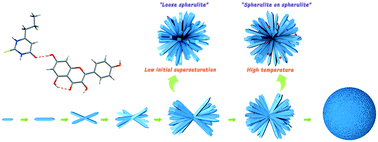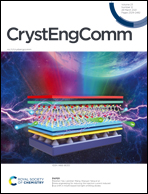Growth mechanism of the spherulitic propylthiouracil–kaempferol cocrystal: new perspectives into surface nucleation†
Abstract
As an emerging technology that can simultaneously improve the powder performance and bioavailability of drugs, spherulitic cocrystallization has increasingly shown its unique advantages. In this study, we reported a new case of a propylthiouracil/kaempferol (PTU–KA) spherulitic cocrystal and explored its growth mechanism. The morphological evolution process and growth kinetics of spherulites were studied using an in situ stereomicroscope and scanning electron microscope. The growth of the PTU–KA spherulitic cocrystal was discovered to have three stages: single crystal growth, non-crystallographic branching, and surface nucleation. It was found that increasing temperature can strengthen the surface nucleation process, and the increasing degree of supersaturation is beneficial to the formation of dense spherulites. An appropriate kinetic model has been established, which has demonstrated that the growth rate curve is not monotonical but has a maximum. Subsequent modeling analysis shows that different stages involve different control steps. Specifically, the non-crystallographic branching process is mainly dominated by interface control, while the surface nucleation process is mainly determined by diffusion control. The results of this work may provide a useful reference for the design and manufacture of spherulitic cocrystals.

- This article is part of the themed collection: Crystal Growth


 Please wait while we load your content...
Please wait while we load your content...